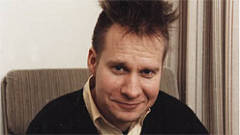An extraordinary foray into the many worlds of renowned artist, opera/theater director, activist and professor Peter Sellars, Art and Life: Finding the Thread offers a unique perspective on the human experience. Shot by the well-known Russian documentary filmmaker Marina Goldovskaya over the course of six years, the film moves effortlessly between the intimate and public worlds Sellars occupies, carrying on a thought-provoking dialogue that stays with the viewer long after the last images have faded from view.
Various aspects of Sellars's multifaceted life are carefully and respectfully portrayed in Goldovskaya's trademark cinematographic style. The film begins with an intimate tea-making ceremony at Sellars's beloved home, which quickly becomes as dramatic as the rest of his colorful existence. His living space is filled with masks, on which Goldovskaya focuses as a subtle commentary upon the many "masks" that Sellars wears: the many worlds he inhabits, the many roles he fills. But masks and masquerades suggest deception, whereas there is a genuine honesty within Sellars, an honesty that is revealed throughout the film. In his quest to connect the disparate threads of art and life, Sellars challenges assumptions, questions authority and stays true to himself. His artistic integrity is inexorably tied to the integrity and passion with which he operates on a daily basis.
The film's exploration of Sellars's worlds continues as the camera captures his participation in various public ceremonies as part of his teaching at UCLA. An obviously brilliant teacher, Sellars challenges his students to think for themselves, then to go beyond that to put those thoughts into action.
Sellars's activism and his unique approach to theater are showcased during the filmed rehearsals of his production of Jean Genet's rarely performed play The Screens, adapted by poet Gloria Alvarez to fit the politically charged climate of East Los Angeles. The cast members, mostly nonprofessional actors drawn from the local Boyle Heights community, grow and change during the course of the production, indelibly affected in a way that resonates years later as Goldovskaya returns to film a moving reunion.
Students, colleagues and friends all speak of Sellars with a deep respect and love that cannot be hidden. But it is when he speaks for himself, as he does through much of the film, that the self-styled "elusive" Sellars becomes uniquely approachable and passionately human. Animated and mobile, when seen through Goldovskaya's inquisitive lens, Sellars is like a puzzle box with numerous compartments, revealing an inner complexity and beauty that hint at even greater depths. Though Sellars denies there is a unifying thread that can be pulled through the body of the film, he himself is that thread -- his passion, his individuality, his creativity, his commitment to social issues all shine through like a bright inner light to illuminate the lives of those around him.
